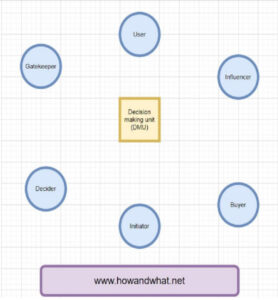Decision making unit (DMU)
This article aims to explore the concept of decision making unit (DMU) in detail. It goes without saying that business decisions are usually taken collectively. A number of people may be involved in the decision-making process and not necessarily, everyone will have the same power. Someone is the most influential, whereas someone is the least. This piece of information is very useful from a supplier’s point of view.
B2B decision making unit (DMU)
According to Kotler & Armstrong (2020), the decision making unit of a buying organisation is called its buying centre. It includes all the individuals and units that play a role in the business purchase decision-making process.
According to the Cambridge Dictionary (2023) DMU refers to a group of people in a company or other organization who are responsible for making important decisions, especially decisions about whether to buy something.
The DMU deals with important decisions, particularly those related to purchasing goods or services from external suppliers. It is a crucial component of the B2B buying process, as it influences the final decision on whether to proceed with a purchase or not.
The composition of a DMU can vary greatly depending on the size and structure of the organization, as well as the complexity and importance of the purchase decision. In some cases, the DMU may consist of just one or two individuals, while in others, it may involve multiple departments and even external consultants. Regardless of the size or complexity, the DMU plays a critical role in determining the success of a B2B transaction.
Key members of a decision making unit (DMU)

Initiators
The initiators are the people who first suggest or think of the idea of buying a particular service or product. They first see the need for the service/product, and then begin the buying conversations within the organisation.
Users
These are the people in an organisations who actually use the products/services and get organisational benefits from them. According to Kotler & Armstrong (2020), the users initiate the buying proposal in many cases.
Influencers
These are the people who can influence the buying decision for a number of reasons. For example, a software engineer may influence an organisation’s decision to buy a new software and where to buy it from.
Buyers
These are the people who have formal authority to negotiate with suppliers. They negotiate and arrange terms of purchase with the suppliers. As negation is a specialist area, high level employees usually play the roles of buyers.
Deciders
Deciders play a very important role in the decision making unit. These are the people who have the final say in the buying decision. They have the power and authority to select the final suppliers to move on with the buying process.
For example, the finance manager in a company may decide which supplier to work with on the basis of how much money the supplier is asking for a particular product/service. Likewise, the CEO may finally turn down a supplier even if the latter has been accepted by the finance manager.
Gatekeepers
Gatekeepers also play a big role in the decision making unit. These are the people who control the flow of information to others. For example, a personal secretary may not allow the salespeople from a supplier to have access to the deciders or users.
Likewise, receptionists may play the role of a gatekeeper as they usually maintain telephone, email, and postal communications. They may simply ignore a sales call!
B2B Decision making process (DMP)
The decision making process (DMP) is the description of the interactions that people in the decision-making unit have with each other in order to make a purchase decision (Stanford University, n.d.). These interactions usually go through a number of steps before a decision is made and they could vary from one company to another.
Robinson, Faris, and Wind divided the buyer purchase process into eight sequential, distinct but interrelated stages as follows:
- Problem recognition
- General description of need
- Product specifications
- Supplier search
- Acquisition and analysis of proposals
- Supplier selection
- Selection of order routine
- Performance review.
B2C Decision making process (DMP) and unit
In the B2C (Business to consumers) context, the decision-making process and unit are usually very straightforward and simple. The unit may consist of only one individual, a couple, or family members.
Example of B2C decision making unit and process
Imagine John wants to buy a can of coke for himself. So, he is the consumer, and does not need to discuss this with anyone. Likewise, he is organising a family holiday which he may have to discuss with his other half, and possibly other family members. And the final decision is taken not by John only, but by everyone involved.
Example of B2B decision making unit and process
Imagine Sylvia works in the IT department of a small company. She identifies that the company needs to buy a new computer for the new IT admin staff (Karim). She then discusses this with her line manager (Alex) who also have the responsibility to make the purchase decision. Alex has agreed, bought a new computer, and passed it on to Karim to use it. In this scenario, Sylvia is the initiator, Alex is the decider and buyer, and Karim is the user.
Role of the decision making unit (DMU) in the purchasing process
The DMU plays a critical role in the B2B purchasing process, influencing the entire decision-making journey. Some key stages where it has a significant impact include:
Identifying needs
The DMU is responsible for recognising the need for a product or service and kickstarting the purchasing process. This stage involves gathering information on potential suppliers and evaluating their offerings to determine the best fit.
Evaluating options
In this stage, the DMU carefully assesses the various available options and weighs the pros and cons of each. This process may involve considering factors such as price, quality, delivery times, and support services.
Making a decision
After evaluating the options, the DMU makes the final decision on whether to proceed with the purchase or not. This decision may be influenced by various factors, such as the organisation’s budget, priorities, and strategic goals.
Implementing the decision
Once the decision has been made, the DMU oversees the implementation of the purchase, including negotiating contracts, coordinating delivery schedules, and ensuring a smooth transition.
Reviewing Outcomes
After the product or service has been implemented, the DMU reviews the outcomes to determine whether the purchase met the organisation’s needs and expectations. This feedback can be invaluable for suppliers looking to improve their offerings and strengthen their relationships with clients.
Summary of decision making unit (DMU)
In conclusion, the decision making unit (DMU) plays a crucial role in determining the success of B2B transactions. By understanding its key members, their role in the purchasing process, and how to effectively engage with them, businesses can increase their chances of success and establish long-term partnerships.
It is worth mentioning that the buying centre is not fixed (Kotler & Armstrong, 2020). An organisation does not need different people to play different roles. One person may play more than one role. Likewise, more than five/six people may also be required sometimes.
According to some writers, the number of people involved in business decision making has gone up from an average of 5.4 to 6.8 recently. In fact, different products/services, and different buying situations will decide how big a buying centre should be.
We hope the article ‘Decision making unit (DMU)’ has been helpful. Please share the article link on social media to support our work.
You may also like reading:
Decision-making – definition and types of decision-making
SWOT analysis of General Motors (GM)
Advantages and disadvantages of a private limited company
Last update: 28 April 2023
References:
Cambridge Dictionary (2023) DMU, https://dictionary.cambridge.org/dictionary/english/decision-making-unit (accessed 06 April 2023)
Kotler, P., Armstrong, G., (2020) Principles of Marketing: Global Edition, 18th Edition, USA: Pearson Education
Stanford University (n.d.) The marketing mix……, available at: https://web.stanford.edu/class/ee204/marketing_example.html (accessed 06 April 2023)
Author: M Rahman
M Rahman writes extensively online and offline with an emphasis on business management, marketing, and tourism. He is a lecturer in Management and Marketing. He holds an MSc in Tourism & Hospitality from the University of Sunderland. Also, graduated from Leeds Metropolitan University with a BA in Business & Management Studies and completed a DTLLS (Diploma in Teaching in the Life-Long Learning Sector) from London South Bank University.



